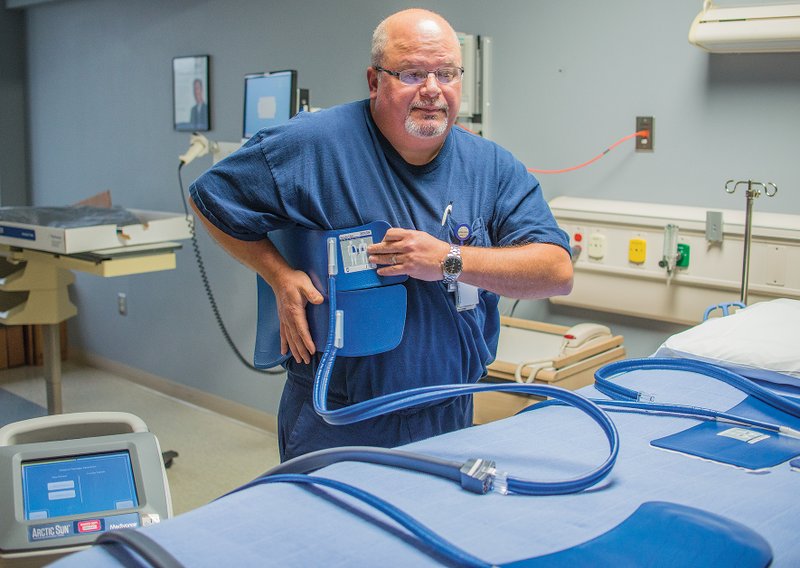On Oct. 29, Randy Jones of the Salem community walked though Saline Memorial Hospital giving out cookies and hugs.
After visiting the emergency department, he then went to the cardiac-care unit of the hospital in Benton. In the lobby, he met with firefighters and ambulance personnel.
“I am alive today because of a lot of people, I am told,” Jones said just before hugging the members of a first-response team from the Benton Fire Department. “It was a big team effort, and I am so fortunate to have had a good team from beginning to end.”
Jones said he is not clear about all the details about his trip to the hospital, but he knows he was close to death, and a series of good things happened quickly, making it possible for him to survive and be able to return to the hospital for a visit and thank those who were there when he needed them.
Jones said he was stacking pallets at his workplace in Benton when he fell over.
“I don’t remember it, but I was told I fell on my side and hit my head on the asphalt,” he said.
From what he was told, Jones said, his boss at the job, Lloyd Wilson, a former firefighter, got to his stricken worker and started CPR only seconds after Jones fell.
Within minutes, a first-response unit of Benton firefighters arrived and used a defibrillator on Jones until he had a steady heart rhythm. An ambulance crew from Saline Memorial then arrived and took Jones to the hospital’s emergency department.
“Once the patient was defibrillated and the rhythm stabilized, but he was still unresponsive, ED doctor Scott Archer called for the core chilling,” said Lee Lessenberry, emergency department coordinator at Saline Memorial.
Dr. Lonnie Harrison, a cardiac interventionist from Arkansas Heart Hospital, was on call for heart-based patients that evening, and he said he lives only 10 minutes from the hospital. He explained the reason the hospital lowered Jones’ body temperature.
“During a heart attack or stroke, there is no oxygen going to the brain,” Harrison said. “When it is restored, that is when there can be brain damage that will last for the rest of your life. Using the Arctic Sun, we can bring the body temperature down slowly so that everything slows and less oxygen is used by the brain, and that means less brain-cell death.”
The Arctic Sun is a cooling machine that is the size and shape of a kitchen garbage can with a swinging door on top. Lessenberry said the chilling machine operates as a thermostat for the body while it is being chilled with hypodermic therapy.
“If we chill the patient less than four hours after the incident, the survival rate is 50 to 55 percent, which is an improvement,” he said. “The body is cooled to 91.4 degrees Fahrenheit, and it keeps things from getting worse.”
Lessenberry said the machine, which he said is one of the most popular of the hypodermic-therapy devices in the nation, then controlled the body temperature of Jones for about 72 hours.
Rolling out the machine, Lessenberry, who is both a nurse and an EMT, said the body is cooled with chilled fluids circulating through large pads that are placed over the body.
“They come in several shapes and sizes to fit the patient,” he said. “They can be placed to cover almost all of the torso.”
While the patient was chilled, Harrison said, his heart was scanned, and no invasive action was taken by the doctors.
Harrison said the patient was given drugs to control shivering, a natural reflex the body uses to try and reheat itself.
“Three days later, we warmed him up, and he came out of the effects of the drugs until he was fully awake,” Harrison said. “The first thing he did was signal he wanted the tube out of his throat, and he started talking.”
Even the doctors say Jones’ recovery was better than expected.
“With everything that went wrong with his heart, it could have been bad, but it wasn’t after this,” Harrison said. “From the immediate CPR and the prompt response of the Benton Fire Department to the quick work in the hospital, things just looked right.”
After waking up from the chilling experience, Jones said, he remembered being in the hospital but only knew about the chilling process from pictures that were taken.
Valeria Henning, who had been with Jones every day at the hospital, said she kept a journal and took pictures so that Jones could see what had happened to him.
“I told him if he ever says he has a bad day,” she said, “I’ll just pull the pictures and journal out so he can realize it isn’t such a bad day.”
Staff writer Wayne Bryan can be reached at wbryan@arkansasonline.com.
